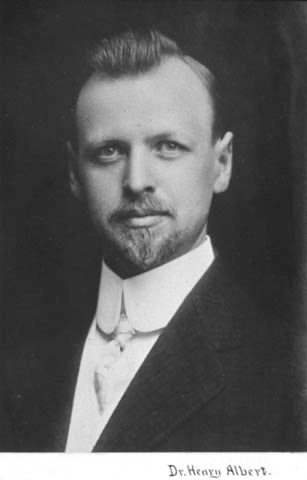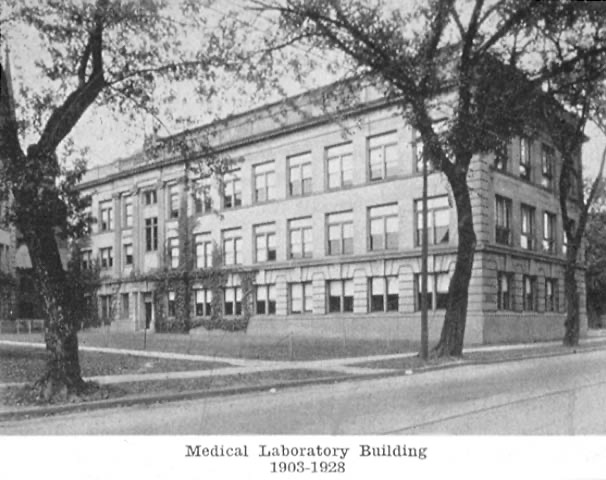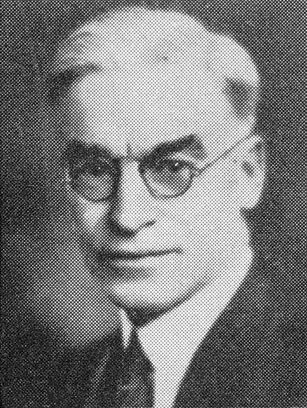Main navigation
Researched and Written by
Dr. Fred Stamler
The University Catalogue of 1903-04 listed Henry Albert, BS, MS, MD, an Acting Professor in charge of courses

in the Department of Pathology and Bacteriology. The following year he held the title of Professor and Head of the Department, and he retained that position until 1921. Like his predecessor, he began preparation for this position as a junior medical student at Iowa City, and after obtaining his MD, he studied in European medical centers before assuming the role of Professor. The Catalogue lists four additional members of the departmental staff, including Charles I. Lambert, MD, as Instructor, Paul S. Krause, BS, as Fellow, Ralph L. Byrnes, BS, as Scholar, and (brother) Fred Albert, Jr., as Laboratory Assistant. This faculty of five was responsible for conducting ten listed courses, the tenth being an advanced course for students working toward a degree in the graduate college. Courses extended through the Sophomore, Junior and Senior years, which now were of 36 weeks duration, and involved classes of as many as 150 students, including those enrolled in he College of Homeopathic Medicine.
The Department moved into its third floor quarters in the new Hall of Histology, Physiology and Pathology in the fall of 1904. This building, later to become known as the Medical Laboratory Building, was the home of the Department for the next 24 years. It housed "laboratories of Pathology and Bacteriology, the Pathological Museum, and Clinical Laboratories." Also in 1904, Henry Albert became Director of the new State Bacteriological Laboratory, later known as the State Hygienic Laboratory, which supplied the Department with much material pertinent to the study of infectious diseases.

The fire of 1901 had destroyed the Medical Museum, so that a call went out for specimens to stock the Pathological Museum of the new building. For several years the University Catalogue listed many donors and their contributions to this collection, which was augmented by material obtained by personal contacts with European Medical centers.
Judging by the University Catalogue, the teaching functions of the Department had become clearly defined by the 1900’s, and there was little change in listings and descriptions of courses during the next several decades. Gross and microscopic features of morbid anatomy were studied intensively, with special emphasis on infectious and neoplastic diseases. Museum specimens as well as current surgical and autopsy material were used extensively for this purpose. Bacteriological studies included practical aspects of preparation of culture media and their use in identification of organisms for diagnostic purposes. These clinically oriented exercises were balanced by thorough didactic lectures and textbook studies of the subject matter.

John T. McClintock became Professor of Physiology in 1903 after serving at various times in Pathology, Anatomy, and Surgery. To prepare for this position he took a leave of absence to study in European laboratories for a year. John W. Harriman died in January, 1904, while serving as Professor of Anatomy. He was replaced the following term by Henry J. Prentiss who headed this Department for many years. The three men (Albert, McClintock, and Prentiss) followed a new trend in medical school policy by practicing their specialties "full-time" as teachers, laboratory investigators and consultants no longer serving as primary care physicians.
During Henry Albert’s term as Department Head, his listed staff varied from three to eight, but the majority were low in rank and short on experience, with titles such as Instructor, Lecturer, Assistant, Demonstrator, or Student Assistant. Assistant Professor A. Egdahl, MD, is listed in 1907-08, the first time that rank was attained in the Department. Egdahl was gone the following year, but several others attained the rank of Assistant Professor in succeeding years. In 1911-12 the title of Hospital Pathologist was given to Mordacai Edlavitch, MD, who promptly vanished from the record at year’s end. This title was bestowed upon a member of the Department each year for some years, but the special nature of that assignment was never explained.
Henry Albert found time to publish a reasonable number of papers during his academic career. Like his mentor, Walter Bierring, his strongest interest appeared to be Bacteriology (infectious diseases) and related public health matters. His publications included case reports and epidemiological observations of such major diseases of the times as typhoid fever, diphtheria, smallpox, gonorrhea, tuberculosis, influenza, trichinosis, and less familiar diseases including rabies, actinomycosis and amoebiasis. His familiarity with this wide range of infectious diseases was enhanced by his experience as Director of the State Hygienic Laboratory, and this knowledge stood him in good stead in his later work in public health.